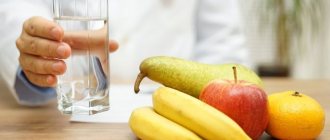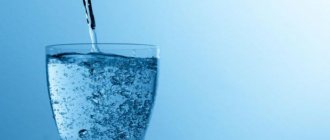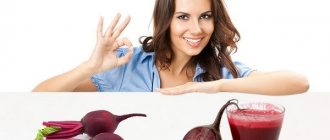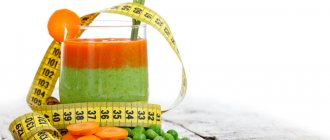Methods for rapid weight loss in rare cases are justified by emergency measures, for example, an upcoming operation. The medical diet was originally invented in order to quickly lose weight before surgery or normalize BMI in the postoperative period. What are the features of the most effective diet, how to eat properly and maintain the results for a long time - more about this in the article.
General rules
The doctors' diet is designed for a certain category of citizens and is not suitable for everyone who wants to lose excess weight .
The nutrition system is designed for people who are preparing for surgical treatment, and who therefore urgently need to get rid of extra pounds. The system assumes full medical support. If there are no indications for using this diet, but if you follow all the rules, you will, of course, be able to lose weight. However, the nutritional system can lead to a slower metabolism, and not a faster metabolism , as many hope. The diet can vary in duration, and the weight can be 10-15 kg. A long course can negatively affect your health. You can avoid the unpleasant consequences of diet by taking multivitamin complexes and minerals.
Only the attending physician can prescribe a diet. If you decide to eat according to this system on your own, it is recommended to consult a doctor and assess the body’s readiness to deal with such stress .
You may need to undergo additional testing. 10-15 kg in 2 weeks is considered a very large weight, which can negatively affect the functioning of the organs and systems of the body. Only with strong motivation can one withstand such severe restrictions.
Contraindications
The doctors' diet cannot be followed in the following situations:
- If inflammatory diseases or processes of internal organs occur in the body;
- If a peptic ulcer has been diagnosed;
- Under the age of 18 or at retirement age.
- It should also be noted that the diet according to this methodology is only allowed to be used once every few months, otherwise serious consequences for digestion and the entire body are possible, since losing 16 kg is already a strong stress.
Indications
The medical diet has 2 main purposes:
- prevention of excess fat deposition in tissue in the presence of concomitant pathology;
- eliminating the accumulation of excess fatty tissue in the body for any type of obesity .
The medical diet is intended for use in cases of overweight, obesity of I, II, III degrees (the underlying disease) and in the presence of other diseases that require special diets if the patient does not have problems with the digestive tract. The diet can be prescribed before surgical treatment, which cannot be carried out in case of obesity.
Program repeat
If, after achieving the desired results, you lead a healthy lifestyle and eat right, you will not have to repeat the course. If after some time there is a slight increase in weight, there is no point in going on such a strict diet. It is enough to reduce the calorie content of the foods you eat, and in a week you will lose 2 kg of excess weight.
If the situation is advanced, the excess weight again goes through the roof, and doctors are allowed to repeat the diet after six months. Here you should think about how effective this technique is. A proper medical weight loss program does not just burn fat, but rebuilds the body and changes a person’s relationship with food. After completing the course, there is no need to repeat exhausting diets.
Authorized Products
The diet is strict and allows the consumption of a very limited number of foods. Broths are allowed: preference is given to chicken broths, but beef broths are also allowed. Meat must be lean, and fermented milk products must be low-fat. Only pure non-carbonated water is allowed for drinks. For tomorrow you can eat boiled eggs.
Table of permitted products
| Proteins, g | Fats, g | Carbohydrates, g | Calories, kcal | |
Vegetables and greens | ||||
| vegetables | 2,5 | 0,3 | 7,0 | 35 |
| greenery | 2,6 | 0,4 | 5,2 | 36 |
Fruits | ||||
| fruits | 0,8 | 0,3 | 11,5 | 56 |
Berries | ||||
| berries | 0,7 | 0,3 | 9,4 | 44 |
Mushrooms | ||||
| mushrooms | 3,5 | 2,0 | 2,5 | 30 |
Dairy | ||||
| skim milk | 2,0 | 0,1 | 4,8 | 31 |
| kefir 0% | 3,0 | 0,1 | 3,8 | 30 |
| kefir 1% | 2,8 | 1,0 | 4,0 | 40 |
| Ryazhenka 1% | 3,0 | 1,0 | 4,2 | 40 |
| katyk 0.1% | 2,8 | 0,1 | 4,2 | 28 |
Cheeses and cottage cheese | ||||
| cottage cheese 0% (low fat) | 16,5 | 0,0 | 1,3 | 71 |
| cottage cheese 0.6% (low fat) | 18,0 | 0,6 | 1,8 | 88 |
| cottage cheese 1.8% (low-fat) | 18,0 | 1,8 | 3,3 | 101 |
Meat products | ||||
| beef | 18,9 | 19,4 | 0,0 | 187 |
Bird | ||||
| chicken | 16,0 | 14,0 | 0,0 | 190 |
| chickens | 18,7 | 7,8 | 0,4 | 156 |
| turkey | 19,2 | 0,7 | 0,0 | 84 |
Eggs | ||||
| omelette | 9,6 | 15,4 | 1,9 | 184 |
| chicken eggs | 12,7 | 10,9 | 0,7 | 157 |
Non-alcoholic drinks | ||||
| water | 0,0 | 0,0 | 0,0 | — |
| mineral water | 0,0 | 0,0 | 0,0 | — |
| * data is per 100 g of product | ||||
Artificial nutrition
In some situations, feeding the patient naturally is impossible: in cases of unconsciousness, mental illness, tongue injuries, stenosis of the esophagus, conditions after surgery on the pharynx, esophagus and other problems. In such cases, food is administered through a nasogastric tube or gastrostomy tube. If it is impossible to introduce food into the stomach, nutrients are given through the rectum or intravenously (parenteral nutrition).
During the day, a patient on artificial nutrition should receive food with a calorie content of about 2000 kcal. In this case, the ratio of BJU is 1:1:4. Water should be supplied in water-salt solutions in the amount of 2 liters per day. Vitamins are either added to food mixtures or given by injection (parenterally).
Only liquid food is administered through a probe or stoma: broth, milk, cream, melted butter, raw egg, vegetable soups (mashed or slimy), liquid jelly, compotes, juices, weak tea. Nutrient mixtures for artificial nutrition are prepared using standard recipes. There are ready-made liquid mixtures, as well as dry ones that require dilution in the required proportion.
Fully or partially limited products
A weight loss diet is based on the complete exclusion from the menu of foods that can increase appetite. The use of extractives and flavorings is prohibited. Extractive substances do not carry any nutritional value, but are quite strong stimulants of the secretion of juices in the digestive system, which has a beneficial effect on the processes of food digestion. However, while taking these substances, there is an increase in appetite, which can have an adverse effect on the weight loss process.
A reduction in the energy value of the diet is achieved through the consumption of easily digestible carbohydrates and fats of plant and animal origin (to a lesser extent). The amount of protein is reduced by eating animal products. Food should be cooked without salt. It is better to replace sugar with sweeteners ( sorbitol , aspartame , stevioside , xylitol , etc.). All smoked foods, pickled foods, and fatty meats are completely prohibited. All pasta and some types of cereals (semolina, rice, beans) are prohibited. Of fruits and berries, restrictions apply only to sweet varieties: dates, watermelons, raisins, grapes.
Table of prohibited products
| Proteins, g | Fats, g | Carbohydrates, g | Calories, kcal | |
Nuts and dried fruits | ||||
| nuts | 15,0 | 40,0 | 20,0 | 500 |
| candied fruit | 2,0 | 1,0 | 71,0 | 301 |
| dried fruits | 2,3 | 0,6 | 68,2 | 286 |
Snacks | ||||
| potato chips | 5,5 | 30,0 | 53,0 | 520 |
| banana chips | 2,3 | 33,6 | 50,7 | 519 |
Cereals and porridges | ||||
| porridge | 3,3 | 1,2 | 22,1 | 102 |
Flour and pasta | ||||
| noodles | 12,0 | 3,7 | 60,1 | 322 |
| spaghetti | 10,4 | 1,1 | 71,5 | 344 |
| pancakes | 6,1 | 12,3 | 26,0 | 233 |
| vareniki | 7,6 | 2,3 | 18,7 | 155 |
| pancakes | 6,3 | 7,3 | 51,4 | 294 |
| dumplings | 11,9 | 12,4 | 29,0 | 275 |
Bakery products | ||||
| baguette | 7,5 | 2,9 | 51,4 | 262 |
| loaf | 7,5 | 2,9 | 50,9 | 264 |
| bagels | 16,0 | 1,0 | 70,0 | 336 |
| buns | 7,2 | 6,2 | 51,0 | 317 |
| pita | 8,1 | 0,7 | 57,1 | 274 |
| pita | 7,4 | 0,8 | 49,9 | 242 |
| bun | 7,6 | 8,8 | 56,4 | 334 |
| Arctic cod | 7,9 | 9,4 | 55,5 | 339 |
| crackers | 11,2 | 1,4 | 72,2 | 331 |
| bread | 7,5 | 2,1 | 46,4 | 227 |
Confectionery | ||||
| baursak | 6,8 | 2,6 | 45,8 | 234 |
| jam | 0,3 | 0,2 | 63,0 | 263 |
| ganache | 4,9 | 34,5 | 52,5 | 542 |
| jam | 0,3 | 0,1 | 56,0 | 238 |
| jelly | 2,7 | 0,0 | 17,9 | 79 |
| marshmallows | 0,8 | 0,0 | 78,5 | 304 |
| candies | 4,3 | 19,8 | 67,5 | 453 |
| Lukma | 2,0 | 2,1 | 75,6 | 380 |
| marzipan | 6,8 | 21,2 | 65,3 | 479 |
| cookie | 7,5 | 11,8 | 74,9 | 417 |
| cake | 3,8 | 22,6 | 47,0 | 397 |
| jam | 0,4 | 0,2 | 58,6 | 233 |
| gingerbread | 5,8 | 6,5 | 71,6 | 364 |
| Sochnik | 10,1 | 8,8 | 40,5 | 274 |
| dough | 7,9 | 1,4 | 50,6 | 234 |
| chuck-chuck | 8,6 | 1,9 | 77,9 | 363 |
Ice cream | ||||
| ice cream | 3,7 | 6,9 | 22,1 | 189 |
Cakes | ||||
| cake | 4,4 | 23,4 | 45,2 | 407 |
Chocolate | ||||
| chocolate | 5,4 | 35,3 | 56,5 | 544 |
Raw materials and seasonings | ||||
| bouillon cube | 2,0 | 2,0 | 4,0 | 40 |
| yeast | 12,7 | 2,7 | 0,0 | 75 |
| honey | 0,8 | 0,0 | 81,5 | 329 |
| sugar | 0,0 | 0,0 | 99,7 | 398 |
| salt | 0,0 | 0,0 | 0,0 | — |
| sumac | 10,0 | 9,0 | 28,0 | 239 |
| fructose | 0,0 | 0,0 | 99,8 | 399 |
Cheeses and cottage cheese | ||||
| cheese | 24,1 | 29,5 | 0,3 | 363 |
Meat products | ||||
| pork | 16,0 | 21,6 | 0,0 | 259 |
| salo | 2,4 | 89,0 | 0,0 | 797 |
| veal | 19,7 | 1,2 | 0,0 | 90 |
| mutton | 15,6 | 16,3 | 0,0 | 209 |
| rabbit | 21,0 | 8,0 | 0,0 | 156 |
| venison | 19,5 | 8,5 | 0,0 | 154 |
| horsemeat | 20,2 | 7,0 | 0,0 | 187 |
| elk meat | 21,4 | 1,7 | 0,0 | 101 |
| yak meat | 20,0 | 3,5 | 0,0 | 112 |
| bacon | 23,0 | 45,0 | 0,0 | 500 |
| ham | 22,6 | 20,9 | 0,0 | 279 |
| steak | 27,8 | 29,6 | 1,7 | 384 |
Sausages | ||||
| boiled sausage | 13,7 | 22,8 | 0,0 | 260 |
| smoked sausage | 28,2 | 27,5 | 0,0 | 360 |
| dry-cured sausage | 24,1 | 38,3 | 1,0 | 455 |
| sausage with/smoked salami | 11,0 | 63,0 | 0,0 | 631 |
| sausages | 10,1 | 31,6 | 1,9 | 332 |
| sausages | 12,3 | 25,3 | 0,0 | 277 |
| pork chops | 10,0 | 33,0 | 0,0 | 337 |
Bird | ||||
| duck | 16,5 | 61,2 | 0,0 | 346 |
| goose | 16,1 | 33,3 | 0,0 | 364 |
Fish and seafood | ||||
| fish | 18,5 | 4,9 | 0,0 | 136 |
Alcoholic drinks | ||||
| absinthe | 0,0 | 0,0 | 8,8 | 171 |
| brandy | 0,0 | 0,0 | 0,5 | 225 |
| bourbon | 0,0 | 0,0 | 0,4 | 235 |
| white wine Muscat | 0,0 | 0,0 | 5,0 | 82 |
| Cahors red wine | 0,0 | 0,0 | 16,0 | 147 |
| whiskey | 0,0 | 0,0 | 0,4 | 235 |
| vodka | 0,0 | 0,0 | 0,1 | 235 |
| grog | 0,0 | 0,0 | 0,0 | 220 |
| gin | 0,0 | 0,0 | 0,0 | 220 |
| cognac | 0,0 | 0,0 | 0,1 | 239 |
| liquor | 0,3 | 1,1 | 17,2 | 242 |
| beer | 0,3 | 0,0 | 4,6 | 42 |
| punch | 0,0 | 0,0 | 30,0 | 260 |
| rum | 0,0 | 0,0 | 0,0 | 220 |
| tequila | 1,4 | 0,3 | 24,0 | 231 |
| chacha | 0,1 | 0,1 | 0,5 | 225 |
| champagne | 0,2 | 0,0 | 5,0 | 88 |
Non-alcoholic drinks | ||||
| cola | 0,0 | 0,0 | 10,4 | 42 |
| coffee | 0,2 | 0,0 | 0,3 | 2 |
| lemonade | 0,0 | 0,0 | 6,4 | 26 |
| Mirinda | 0,0 | 0,0 | 7,5 | 31 |
| Pepsi | 0,0 | 0,0 | 8,7 | 38 |
| sprite | 0,1 | 0,0 | 7,0 | 29 |
| Fanta | 0,0 | 0,0 | 11,7 | 48 |
| green tea | 0,0 | 0,0 | 0,0 | — |
| black tea | 20,0 | 5,1 | 6,9 | 152 |
Juices and compotes | ||||
| compote | 0,5 | 0,0 | 19,5 | 81 |
| juice | 0,3 | 0,1 | 9,2 | 40 |
| * data is per 100 g of product | ||||
Catering in medical institutions
One of the most important segments of medical care in inpatient medical institutions is that patients, or patients, must have a balanced diet. The process of preparing, serving, and eating food must be organized in accordance with the existing regulatory framework. The main document in this case is Order of the Ministry of Health of the Russian Federation dated August 5, 2003 N 330 “On measures to improve clinical nutrition in medical institutions of the Russian Federation.” The standards are regulated by the document Order of the Ministry of Health of the Russian Federation dated June 21, 2013 N 395n “On approval of clinical nutrition standards.”
Responsible for dietary nutrition
Control over the organization of nutrition in medical institutions lies with the dietitian, senior nurse and dietitian. In hospital departments, guard nurses provide information to the head nurse every morning about the number of patients, indicating diet numbers.
Read also: Diet number 4 for intestinal diseases with diarrhea
The head nurse, in turn, summarizes the data, summing up the number of tables. Then he draws up a portion requirement (“portion plan”), which he passes on to the diet nurse. The nutritionist, having received portions from each department, submits a general summary to the catering department. For new admissions, especially for emergency reasons, information is transmitted by the admissions department nurse or guard nurse immediately after the patient is admitted to the hospital.
Meals in the department
In the kitchen of a hospital, sanatorium or dispensary, food is prepared based on portion requirements. Buffet employees (distributors) either receive food for the department at the catering units, or accept food delivered directly to the department’s buffet. Patients are fed in the dining room or in the wards. Before eating, the nurse must complete all manipulations with patients. If feeding takes place in the ward, ventilation must be done. The patient should wash their hands.
For the optimal effect of therapeutic nutrition, the external conditions of food intake are also important. The dining room should be clean, bright, and comfortable. Tables are set neatly, and employees involved in feeding patients must have a neat, well-groomed appearance. Food is served warm. Dishes should look appetizing and beautiful. Patients should maintain a calm environment while eating.
After each meal, tables are cleaned and floors are washed. Tables and chairs must have surfaces that can be wet cleaned and disinfected with solutions. At the end of the working day, tables must be washed with hot water in compliance with occupational safety regulations. After use, dishes should be washed and disinfected in accordance with SanPiN 2.1.3.2630-10 and SanPiN 2.3.6.1079-01. Food waste is disposed of in accordance with SanPiN 2.1.7.2790-10.

Doctors' diet for 7 days and 14 days, menu (Meal schedule)
The shortest medical diet lasts 7 days. Below will be presented a seven-day fasting diet, the recipe was developed by doctors.
It is recommended to study the menu in advance in order to prepare all the necessary products and prepare yourself mentally for a week of limited nutrition.
The first day
It is a cleansing fast. On this day you can only drink water, the permitted volume is 1.5 liters.
Second day
A little easier than the first one. On this day you can drink skim milk (4 glasses). You are allowed to eat 1 apple at 7 pm.
Day three
Again a fasting day, on which you can only drink water (volume 1.5 liters). This concludes the most difficult part of the diet.
Day four
Cabbage salad with the addition of greens and carrots (volume for the whole day - 1 liter). The salad can be dressed with olive oil.
Day five
The menu for this day duplicates the second day of the diet, on which you can drink only 4 glasses of skim milk per day.
Day six
| Breakfast |
|
| Dinner |
|
| Dinner |
|
Day seven
| Breakfast |
|
| Dinner |
|
| Dinner |
|
Doctors' diet for 14 days
The diet menu completely duplicates the 7-day diet option. The medical diet for 2 weeks is more difficult to tolerate and is recommended for those who have already tried the 7-day diet and tolerated it well. Initially, going straight to the 14-day course without preparation is not recommended. The reviews are very different: in terms of effectiveness - positive, in terms of tolerability - negative.
Side effects
Adverse effects occur during the diet and after it ends.
- Vitamin deficiency , deterioration of the condition of nails, hair, skin. After losing weight, it will take a long time to restore them.
- Weakness, decreased performance, dizziness, headache.
- Diarrhea, exacerbation or development of diseases of the digestive tract.
- Insomnia at night, drowsiness during the day, irritability, depression, bad mood.
- Constant feeling of hunger.
- A starvation diet disrupts metabolic processes . During the medical diet, the body begins to save energy, and after returning to normal, it quickly tries to restore what was lost.
- Eating disorders cause the body to stop recognizing the real feeling of hunger. I want to eat constantly or a lot. Due to overeating, excess weight appears again.
- During a starvation diet, blood circulation to the brain is disrupted. In addition to headaches and dizziness, memory deteriorates, concentration decreases, and psychomotor skills change for the worse.
- Sagging skin with rapid weight loss is inevitable , as is the appearance of unsightly stretch marks. Along with the fat layer, the volume of muscle mass decreases.
Attention! The so-called medical diet leads to the fact that it takes a long time for real doctors to eliminate its consequences, and this is not always possible.
Video: Diet of doctors
Quitting the diet
When the diet is over, another important moment comes - the exit period, which requires no less pronounced efforts than the nutrition system itself. Judging by the reviews, after 7 or 14 days of the diet, it is very difficult to follow any other rules and restrictions. At the end of the course, the body’s metabolism is very slow, and the body is in strict energy saving mode. If you return to your usual diet, the body will quickly gain reserves, because... is in a state of energy and nutritional deficiency. That is why portions need to be increased gradually, from week to week.
It will be more effective if the portions are increased by adding leafy greens and fresh vegetables. Small portions of porridge or meat are psychologically easier to bear if served on a plate filled with fresh cucumbers, herbs, carrot slices, pepper rings, etc. Try to replace unhealthy foods with healthy ones: instead of sweets - prunes, instead of spaghetti and pasta - fresh vegetables as a side dish, dairy products - low-fat. When leaving the diet, to maximize the results, it is important to completely give up fried foods, sweets and fatty foods.
Summing up
In this article, we did not touch upon the topic of “Fashionable diets” and other dietary nutrition technologies that are not recognized by medicine. But there are still many therapeutic diets that are not described in the article, but they, as a rule, are either analogues of those given here, or are prescribed in rare cases. You may hear about gluten-free, diabetic, low-purine, pancreatic, low-salt, low-cholesterol, tube, ketogenic, vegetarian, Mediterranean, DASH, or reduction diets. All of them are prescribed individually by the attending physician of the sanatorium or spa hotel, and in any case you will be told in detail about them. Follow the regime, eat right, follow the doctor’s recommendations and the positive effect will not be long in coming. Sanatoriums.com sends greetings to everyone and wishes them good health!
Advantages and disadvantages
| pros | Minuses |
|
|
Rules for distributing food to patients in a hospital
- Food is distributed by the barmaid (distributor) together with the ward nurse according to portion requirements. Before distributing food, they put on gowns marked “for food distribution” and wash their hands thoroughly.
- Nurses cleaning premises are not allowed to feed patients.
- Seriously ill patients are required to be fed by a nurse. Feeding is carried out within the ward, at the patient’s bedside. Food for such patients is delivered to the ward by a barmaid on a special table on wheels. Immediately after feeding, dirty dishes and leftover food are removed from the room to the washing buffet.
- Patients assigned to the general regime eat in the dining room. All patients must wash their hands before eating, and this is supervised by a nurse.
We hope that after reading the article, readers have a picture in their heads about what therapeutic nutrition is, how it is organized and what responsibility lies with the nurse.
Doctors' diet: reviews and results
The medical diet is gaining popularity today. On thematic forums you can find menus and results, but they often present embellished results. The presented diet is very complex and requires complete willpower. It will be better if you find like-minded people who can support you every day in difficult times, at the risk of failure. When evaluating reliable reviews, we can conclude that a medical diet for weight loss allows you to get rid of 5-7 kg in 7 days and 14 kg in 14 days.
Photos of results
Reviews of the medical diet for 7 days are mostly positive. On average, 1 kg is lost per day. The number of kilograms lost largely depends on the initial weight: the higher it is, the greater the weight. The diet is not recommended for those who want to get rid of 3-5 kilograms or less. For these cases, there are softer, balanced diets that are safe for health. The effectiveness of the medical diet is proven by the results with photos.
Basic principles
The extreme method of losing weight requires compliance with certain rules.
- The daily calorie content of meals should not exceed 770 kcal. In the benefits, adherents of the program indicate that there is no need to do this if you adhere to the proposed diet.
- Low-calorie protein foods are allowed - lean meat, low-fat fermented milk, dairy products, as well as plant fiber.
- You need to drink at least 2 liters of non-carbonated mineral or spring water per day. The liquid helps remove toxins and waste.
- Before starting a diet, doctors recommend seeking help from specialists, which is quite surprising. If this is a “medical” program, then it must take into account the problems and health conditions of overweight people.
- Since rapid weight loss leads to sagging skin, it is recommended to do cosmetic procedures at home to prevent this phenomenon. It is suggested to make scrubs, moisturize the skin with lotion, apply masks, and massage problem areas. As practice shows, all these measures do not bring the desired result with rapid weight loss. More effective are shapewear, special exercises to increase muscle elasticity, as well as surgery.
- The so-called diet of doctors can hardly be called balanced, so it is suggested to additionally use vitamin complexes and sedative mixtures.
- It is necessary to limit physical and mental stress. The conclusion suggests itself that you need to lose weight in your free time from work, for example, on vacation.
- To distract yourself, dull the feeling of hunger, and calm the nervous system, you need to spend more time in the fresh air. There is also one significant nuance here. When you are in the fresh air, more oxygen enters the body's cells, and organs and systems begin to function more actively. After a walk, the feeling of hunger increases and appetite increases.
- Smoking and drinking alcohol are prohibited. Bad habits slow down the process of losing weight because they disrupt metabolic processes.
- While losing weight, you should not drive or do work that requires precision or high concentration.
- You definitely need to get a good night's sleep, which is also not always possible. Firstly, hunger prevents you from falling asleep and sleeping normally, and secondly, your digestive system malfunctions. When problems with the intestines occur, insomnia, early awakening, constant drowsiness, and fatigue are observed. In this case, even if you sleep for days, you will not feel good.
- The last meal should be no later than 21:00. During the day you are allowed to eat the offered dishes at any time.
- You need to initially prepare for the medical diet. It is forbidden to rarely switch to the proposed menu. Over the course of a week, it is recommended to gradually reduce the calorie content of foods to 1400 kcal.
As a standard, it is prohibited to consume high-calorie foods - fried, salty, spicy, sweet, fatty, smoked foods.
Video: Really the most effective diet for seven days!










